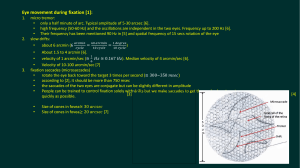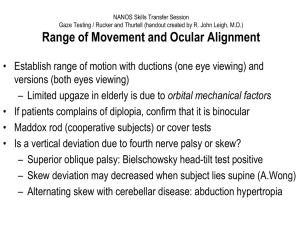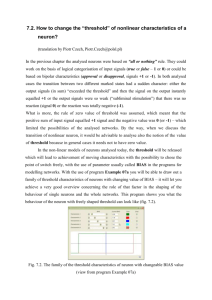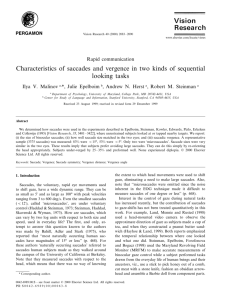Supplementary Information Title: Microsaccades are different from
advertisement
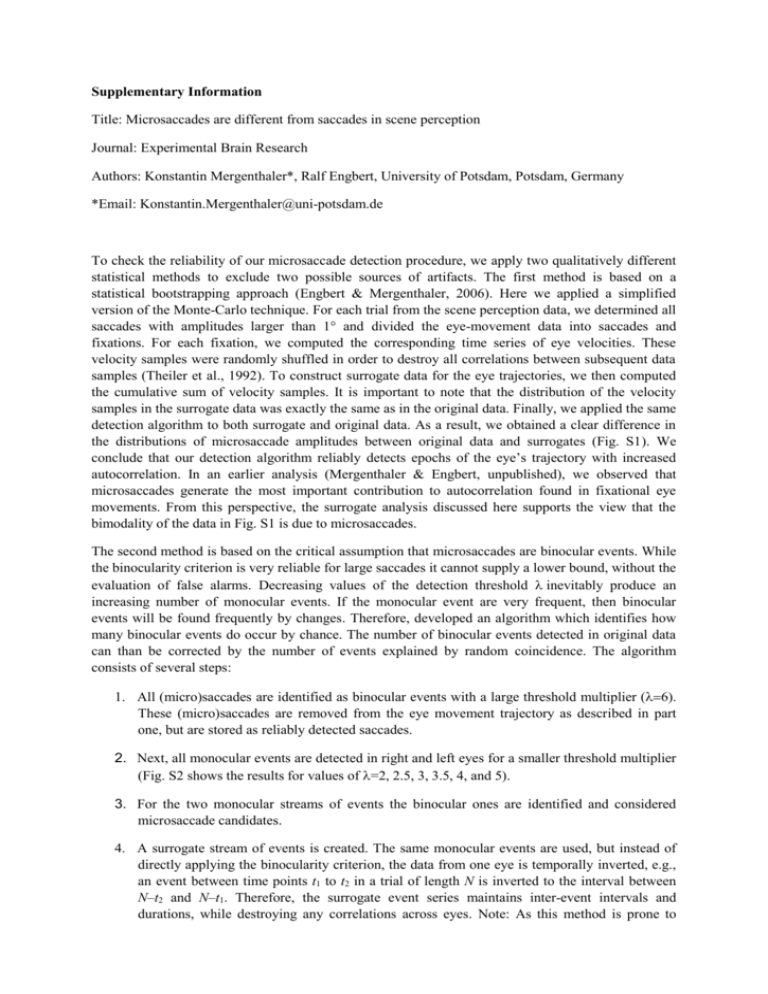
Supplementary Information Title: Microsaccades are different from saccades in scene perception Journal: Experimental Brain Research Authors: Konstantin Mergenthaler*, Ralf Engbert, University of Potsdam, Potsdam, Germany *Email: Konstantin.Mergenthaler@uni-potsdam.de To check the reliability of our microsaccade detection procedure, we apply two qualitatively different statistical methods to exclude two possible sources of artifacts. The first method is based on a statistical bootstrapping approach (Engbert & Mergenthaler, 2006). Here we applied a simplified version of the Monte-Carlo technique. For each trial from the scene perception data, we determined all saccades with amplitudes larger than 1° and divided the eye-movement data into saccades and fixations. For each fixation, we computed the corresponding time series of eye velocities. These velocity samples were randomly shuffled in order to destroy all correlations between subsequent data samples (Theiler et al., 1992). To construct surrogate data for the eye trajectories, we then computed the cumulative sum of velocity samples. It is important to note that the distribution of the velocity samples in the surrogate data was exactly the same as in the original data. Finally, we applied the same detection algorithm to both surrogate and original data. As a result, we obtained a clear difference in the distributions of microsaccade amplitudes between original data and surrogates (Fig. S1). We conclude that our detection algorithm reliably detects epochs of the eye’s trajectory with increased autocorrelation. In an earlier analysis (Mergenthaler & Engbert, unpublished), we observed that microsaccades generate the most important contribution to autocorrelation found in fixational eye movements. From this perspective, the surrogate analysis discussed here supports the view that the bimodality of the data in Fig. S1 is due to microsaccades. The second method is based on the critical assumption that microsaccades are binocular events. While the binocularity criterion is very reliable for large saccades it cannot supply a lower bound, without the evaluation of false alarms. Decreasing values of the detection threshold inevitably produce an increasing number of monocular events. If the monocular event are very frequent, then binocular events will be found frequently by changes. Therefore, developed an algorithm which identifies how many binocular events do occur by chance. The number of binocular events detected in original data can than be corrected by the number of events explained by random coincidence. The algorithm consists of several steps: 1. All (micro)saccades are identified as binocular events with a large threshold multiplier (6). These (micro)saccades are removed from the eye movement trajectory as described in part one, but are stored as reliably detected saccades. 2. Next, all monocular events are detected in right and left eyes for a smaller threshold multiplier (Fig. S2 shows the results for values of =2, 2.5, 3, 3.5, 4, and 5). 3. For the two monocular streams of events the binocular ones are identified and considered microsaccade candidates. 4. A surrogate stream of events is created. The same monocular events are used, but instead of directly applying the binocularity criterion, the data from one eye is temporally inverted, e.g., an event between time points t1 to t2 in a trial of length N is inverted to the interval between N–t2 and N–t1. Therefore, the surrogate event series maintains inter-event intervals and durations, while destroying any correlations across eyes. Note: As this method is prone to randomly combining real microsaccades (i.e., those detected at the larger threshold in step 1.) it dictates to operate on the reduced data set without (micro)saccades detected at the larger threshold. 5. The number of binocular events obtained in step 3. is now reduced by the number of random coincidences in step 4. 6. Finally, the (micro)saccades identified in step 1. are added to the (micro)saccades. Results are plotted in Fig. S2. First, the is an increasing number of microsaccade candidates for decreasing values of the threshold. However, the number of random coincidences (from the bootstrapping procedure) increases even faster than the number of microsaccade candidates. As a results, the remaining number of microsaccade candidates (reduced by the number of random coincidences) starts to fall for threshold values smaller than 3 Thus, the optimal detection threshold, which verifies the bimodality of the distribution, can be found in a range between 3 and 3.5 References Engbert R, Mergenthaler K (2006) Microsaccades are triggered by low retinal image slip. Proc Natl Acad Sci USA 103: 7192–7197 Mergenthaler K, Engbert R Microsaccade detection: Statistical testing using surrogate data and effects of inter-individual differences and variations in luminance. Unpublished manuscript Theiler J, Eubank S, Longtin A, Galdrikian B, Farmer JD (1992) Testing for nonlinearity in timeseries—The method of surrogate data. Physica D 58: 77–94 Fig S1. (A,C,E) Comparison of amplitude distributions during scene viewing of original data and surrogates generated within fixations. (A) Saccadic-events were detected with a threshold multiplier =2.5. The pronounced maximum at 0.05° in the surrogate data suggests that the threshold multiplier is too small is this case. (C) Saccadic-events were detected with a threshold multiplier =3. This is the value applied throughout the article. The maximum at 0.05° nearly disappears in the surrogate data, which suggests that =3 is an adequate choice for the analysis of our data. (E) Saccadic-events were detected with a threshold multiplier =4. The value appear to be too large to observe the clear bimodality in the amplitudes. (B,D,F) Comparison of inter-event intervals obtained for saccadic events (<0.4°) for original data and surrogates. Fig S2. Analysis of random coincidences of binocular events. The blue curve denotes the amplitude histogram for the (micro)saccades detected for =6 (same curve for all plots). Across the figures from A to F the threshold multiplier for the additional reliable binocular microsaccades is varied in increasing order (A: =2.0, B: =2.5, C: =3.0, D: =3.5, E: =4.0, F: =5.0). Rates of microsaccades are given in the plots. The number of binocular events which could not be explained by random concurrence increases from =2.0 to =3.0 and declines for higher Thus, the optimal signal-tonoise ratios is obtained in the range from =3.0 to =3.5.
